

John Beckwith. Psalmody in British North America: Humbert, Daulé, Jenkins, Burnham. Toronto: Coach House Printing, 2002. 63 pp., ill., music. ISBN 0-9699416-1-7. $20 (paper), available from the Institute for Canadian Music.
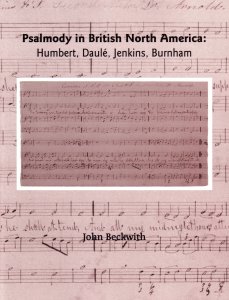
This publication is an outgrowth of a paper John Beckwith delivered for the conference Toronto 2000 – Musical Intersections. It deals with four early volumes of vocal music first published in Saint John, Quebec City, Montreal, and Port Hope respectively between 1801 and 1832. There is a brief essay on each of the four volumes under discussion and an invaluable series of tables summarizing the contents of the publications and giving detailed information about the contents of different editions, the sources of the tunes, and indices for the volumes.
There is a great deal of interesting information in this slim volume. Beckwith notes that Daulé’s Nouveau Recueil de Cantiques, published in 1819, contains a tune from Quesnel’s Colas et Colinette, which was premiered in Montreal in 1790. Given that Quesnel’s score was not published until 1974, Beckwith suggests that either Quesnel’s tune passed into oral tradition, a not uncommon occurence with popular opera airs, or that both Daulé and Quesnel borrowed the tune from a common earlier source. The latter theory raises the interesting possibility that perhaps all of Quesnel’s tunes are borrowed rather than original material. This would not have been unheard of in the 18th century, as witnessed by that ever-popular pastiche The Beggar’s Opera. Beckwith further notes that three tunes cited in Longfellow’s Evangeline (first published in 1847) are in the Daulé volume, though Longfellow may have gotten these texts from a prior source published in Quebec City in 1795 without the music.
Although all four volumes contain sacred vocal music, Beckwith speculates that only one (Jenkins) was likely used mostly in church services, while two (Humbert and Burnham) were used mainly outside of church, and one (Daulé) was used entirely outside of church. Although it can be problematic at best to speculate about such matters, one is tempted to trust Beckwith’s instincts in this regard. As Beckwith notes in his introduction to the volume, "tunebooks were produced for educational and social purposes" and were "absorbed in social arenas – the singing school, choral circle, or family parlor – as much as,perhaps even more than, in public worship" (p. 5).
The most interesting of the four publications is, to this reader at least, Burnham’s Colonial Harmonist. The Humbert, Daulé, and Jenkins volumes seem to be the products of a musical diaspora – the work of an American, a Frenchman, and a Welshman who just happened to live in British North America. Burnham’s publication, though, with its mixture of classical European sources, old-fashioned and reform American psalmody, and newly composed pieces, some with overtly Canadian titles, strikes one as somehow authentically (Upper) Canadian in a way that the earlier books are not. Of added interest is the fascinating tale of the proposed but presumably never published second edition of Colonial Harmonist. When visiting Burnham’s descendants on their farm near Cobourg in August 2000, Beckwith was shown their "edition" of Colonial Harmonist. This consisted of the binding of the original 1832 edition, with about 90 percent of the contents removed and manuscript pages pasted on to the stubs of the original pages. Added by hand to the printed title page are the words "Second Revised Edition With Additions and Improvements," and the 1832 date has been changed to 1836. Beckwith immediately realized the historic importance of this unique manuscript edition, and arranged for it to be purchased by the University of Toronto. It now rests in the Rare Book Room of the Faculty of Music Library, and a fascinating document it is. Future researchers are thus in Beckwith’s debt not only for his painstaking and insightful investigations into this repertoire, but also for making this particular source available to the wider academic community. Robin Elliott
William Aide. Sea Voyage with Pigs. [Ottawa]: Oberon Press, 2002. 56 pp., music, CD. ISBN 0-7780-1199-2 (cloth), 0-7780-1201-8 (paper). $31.95 (cloth), $15.95 (paper).
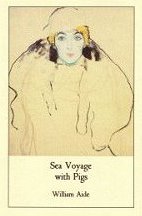
William Aide, who retires from the Rupert E. Edwards Chair in Piano Performance at the University of Toronto in 2003, launched this book of poetry at his farewell recital in the university’s Walter Hall on 25 October 2002. Each of the 24 poems in this volume is about one of Chopin’s Préludes, Op. 28, with a cleverly annotated score excerpt on the facing page. The book generously comes with a very fine CD of Aide performing the preludes, which is a nice companion piece to his recording of the Chopin études made 15 years ago (CBC Musica Viva MVCD 1017). The title is taken from the last poem, which is about Chopin and his lover George Sand on their return journey from the island of Majorca (where the Préludes were completed in 1839) to France in a ship that was carrying pigs as cargo. Each poem captures a different aspect of this popular set of piano miniatures, and takes in such diverse characters as Kafka, Jane Stirling, Gershwin, Debussy, Julian Fontana, Claudio Arrau, Martha Argerich, Schumann, Liszt and of course George Sand, whose shocking insensitivity and admirable tenderness are captured at one and the same time in Aide’s wonderful final poem. Robin Elliott
Alan Jackson and James Bailey. Organs of Toronto. Toronto: Royal Canadian College of Organists, 2002. 156 pp., ill. ISBN 0-9689713-0-X. $45 (paper).
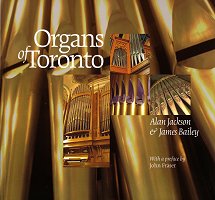
This stunningly beautiful book is a magnificent tribute to its subject. Jackson, who is district representative for Casavant Frères, runs a company that services pipe organs of all types. Bailey is an organist and architect. Together they present detailed information about the construction and characteristics of each of the 36 organs featured, and cogent and informed comments about the architecture and history of the buildings (34 churches, along with Roy Thomson Hall and Convocation Hall) that house the instruments. You have my personal guarantee that Brian J. Thompson’s photographs will take your breath away. Regardless of whether or not you like the sounds that they make, the fact remains that organ pipes and consoles present a fascinating set of visual variations on a given theme. Complete specifications are given for each of the instruments, and a very useful glossary explains organ terminology in layman’s terms for the uninitiated. Add to this the exquisite design and typography by Willem Hart, and the result is an exceptionally beautiful and informative book. Hats off to the Ontario Trillium Foundation, which purchased 600 copies of the book to distribute in schools and libraries. Robin Elliott
I had to search long and hard to find out who was responsible for putting this volume together. In small print on p. 189 Malcolm Lester seems to take credit for compiling it, while acknowledging that the Estate of Glenn Gould and its executor Stephen Posen first conceived of the idea for it (not that it was much of an idea – "Let’s do a coffee table book of black and white Gould photos and get a celebrity musician or two to write some text for it"). With a foreword by Yo-Yo Ma and an introduction by Tim Page, this is another installment in the ongoing hagiography of Gould, this time to commemorate the 20th anniversary of his death (and the 70th of his birth). The Gould Estate recently took a court action against Stoddart Publishing and the estate of Jock Carroll for publishing a similar book of Gould photos (Glenn Gould: Some Portraits of the Artist as a Young Man, 1995). The Ontario Court of Appeal ruled that the copyright in the photos was Carroll’s and not the Gould Estate’s, and the Supreme Court of Canada in 1999 denied the estate’s application to have the decision appealed (see Jeffrey Miller, "Glenn Gould and the piano of justice," The Lawyers Weekly, 11 October 2002). It looks like this is a case of if you can’t beat them, join them ... Robin Elliott
[Malcolm Lester, compiler]. Glenn Gould: A Life in Pictures. [Toronto]: Doubleday Canada, 2002. 192 pp., ill. ISBN 0-385-65903-2. $50 (cloth).
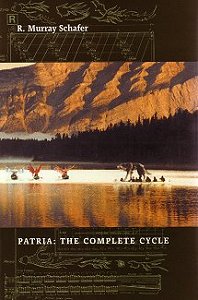
R. Murray Schafer. Patria: The Complete Cycle. Toronto: Coach House Books, 2002. 272 pp., ill., music. ISBN 1-55245-109-7. $22.95 (paper). Web: www.chbooks.com
It is finished. At least the text is. The present volume is advertised as the "new definitive edition" of Schafer’s massive Patria series of music theatre works, which has been some 40 years in the making. The book contains essays about all 12 works in the series (Patria 1-10, along with a prologue and epilogue), plus an essay on Schafer’s first stage work, Loving, and three essays on his theory of "the theatre of confluence." There are score excerpts and photos from productions of the works. Much of this material was published in the literary magazine Descant (no. 73, vol. 22/3, Summer 1991; republished as a monograph by Schafer’s Arcana Editions), although at that time Schafer had only completed up to Patria 7. The third of the essays on the theatre of confluence, along with Patria 8-10 and the Epilogue, are new with this publication. With the production of Patria 8: The Palace of the Cinnabar Phoenix in September 2001, only Patria 7: Asterion is yet to be performed of the 12 works that make up the Patria cycle. At www.patria.org you will find further information about the Patria series and a newsletter, which can be downloaded. Robin Elliott
Richard S. Warren. Begins with the Oboe: A History of the Toronto Symphony Orchestra. Toronto: University of Toronto Press, 2002. 287 pp., ill. ISBN 0-8020-3588-4. $60 (cloth)
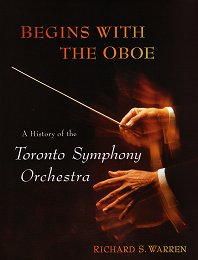
On December 1st, 2001 while visiting Toronto from Dublin, I attended a concert by the Toronto Symphony. Roy Thomson Hall was half empty, the orchestra looked diffident if not downright apathetic, the playing was perfunctory, and both the musicians and the audience seemed relieved when it was all over and we could get on with the rest of our evening. The TS was in the midst of an ongoing crisis of finances and morale, and in imminent danger of ceasing operations altogether. On the strength of my admittedly isolated experience that night, pulling the plug on the TS would have amounted to euthanasia rather than murder. Long gone are the days when the TS season dominated the musical life of Toronto; it is now just another arts organization, and a rather cumbersome one at that, fighting hard to maintain its share of an increasingly fragmented market for live music. Under the chairmanship of former Ontario premier Bob Rae, the TS board of directors is faced with the unenviable task of bringing the orchestra back from the dead. The present history of the TS, published for the launch of the orchestra’s 80th season, appeared shortly after the death of the author, who served as the TS archivist for 26 years. A season by season narrative is illustrated by black and white photos of musicians and a few programmes. Included in the appendices are lists of TS musicians and recordings, and Canadian works the orchestra has commissioned since 1960 (69 in all, not including the work by Luigi Nono listed). In the Afterword to the book, Rae opines that the root cause of the TS’s problem is civic decline. Sadly enough, he seems to be right. Robin Elliott
the world of music: Indigenous Popular Music in North America: Continuations and Innovations, Karl Neuenfeldt, guest editor (vol. 44.1). Berlin: VWB – Verlag für Wissenschaft und Bildung, 2002. ISSN 0043-8774 / ISBN 3-86135-730-5. €50 for a one-year subscription; web: World of Music.
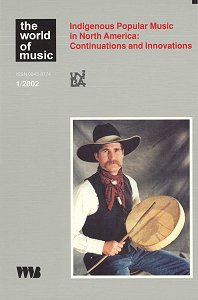
Each essay in this issue of the International Music Council’s journal the world of music addresses an aspect of transculturation in recent Native North American music. Citing Mary Louise Pratt’s Imperial Eyes: Travel Writing and Transculturation (New York: Routledge, 1992), Neuenfeldt defines transculturation as "the way members of minority or marginalized groups choose or refashion materials transmitted by a dominant culture" and notes that music is one contact zone where different cultures "meet, clash, and grapple with each other, often in highly asymmetrical relations of domination and subordination" (p. 7). This contact raises issues of hegemony, post-colonialism, and cultural hybridity. Seven essays in this volume – by Neuenfeldt, Beverley Diamond, Christopher A. Scales, Elaine Keillor, Annette Chrétien, Anna Hoefnagels, and Klisala Harrison – deal with Native or Métis musicians active in Canada. Diamond’s essay on the rise of Native women musicians in the popular music arena during the past decade presents many important theoretical issues: on the positioning of Native women musicians within mainstream popular music, individual versus community values, authenticity, and so on. An important aspect of her contribution is the generous amount of space she opens up for the voice of the Native women themselves. Other essays in the volume deal with the politics and aesthetics of making Native recordings, the Internet as a marketing vehicle for Native music, rodeos, powwow songs, Métis identity, and First Nations intellectual property issues. Robin Elliott
Canadian Winds • Vents canadiens, Revue de l’Association canadienne de l’harmonie / The Journal of the Canadian Band Association, vol. 1, no. 1 (Autumn 2002), Denise Grant and Timothy Maloney, editors. Free to all members of the Canadian Band Association; non-member annual subscriptions (for two issues) cost $16.00 plus $9.00 shipping and handling (tel. Ken Epp 204 663 1226 / email mbband@merlin.mb.ca).
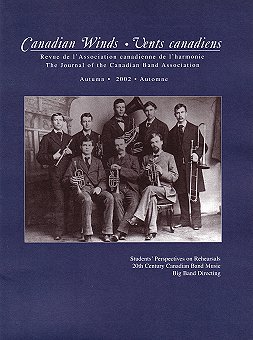
The Canadian Band Association was founded in Toronto in 1931 and currently has 1,800 members. Over the years it has produced a number of periodicals: The Canadian Bandsman (1942-9), The Canadian Bandmaster (1949-67), The CBDA Journal (1976-84), and the Canadian Band Journal (1984-2001). The CBJ ceased publication when its editor, Keith Mann, died. Now a new journal has been launched, under the joint editorship of Denise Grant of the University of Toronto and Timothy Maloney, the former Director of the Music Division of the National Library of Canada who in the autumn of 2002 was appointed to be the head of the music library at the University of Minnesota.
The band world has been slow to make space for women participants, especially in leadership roles. Indeed, this is one focus of the research of Elizabeth Gould, a visiting professor in music education this year at the University of Toronto. The cover of the first issue of this new journal seems to perpetuate that male bias, with a picture of the eight men (and no women) of the Orangeville Band of 1878. But the contents belie that image, with Grant not only as co-editor, but also as contributor of two articles.
This handsomely produced and well edited journal concentrates on practical rather than theoretical issues, with articles on band rehearsals, conducting and performing. There is an article by Maloney on 20th-century Canadian wind ensemble repertoire, and a brief history of the Canadian Band Association by Allan J. Calvert, who has been a member since 1949. There are also book and CD reviews, and a representative list of recent band programmes from across the country. Robin Elliott
The Heart of Cape Breton: Fiddle Music Recorded Live along the Ceilidh Trail. Smithsonian Folkways CD recording SFW CD 40491. US $15.00; see Smithsonian Folkways Recordings for details, and Cranford Publications for some sample transcriptions.
An interesting development in the recording industry during the past ten years has been the change in packaging and distribution of world music CDs. [I am conscious of the controversies over the term "world" music and of the irony of discussing a recording of Canadian music in a Canadian newsletter in terms of "world" music; nevertheless, I feel that it retains a degree of usefulness even in this context.] In 1993 the clothing company Putumayo began producing attractively packaged and imaginatively marketed compilations of world music. National Geographic, Rough Guides, and other non-music companies have now entered the field with much success.
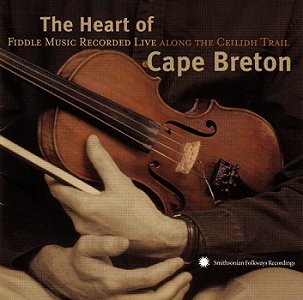
But long before world music was turning up at coffee shops and clothing boutiques, there was Moses Asch and his Folkways Records, founded in 1948. The Folkways catalogue of 2,200 recordings was acquired by the Smithsonian Institution in 1987, and many further recordings have been produced since then on the Smithsonian Folkways label. The current CD was recorded in July 2000 and released in February 2002. It features extensive liner notes by Burt Feintuch, a folklorist (and fiddler) at the University of New Hampshire.
One reason Cape Breton fiddling has become well known to the wider world is because of the huge success of the (third) cousins Natalie MacMaster and Ashley MacIsaac. The two young musicians (she’s 30, he’s 27) studied together as children but have since taken their fiddling down quite radically divergent paths. They present such an extreme good girl/bad boy split, both musically and in terms of their personal life, that it almost seems like a scripted act.
The present CD provides a context for hearing Natalie and Ashley in terms of the fiddling tradition in which they both grew up and to which they continue to return. It may seem unfair to reduce the exceptionally fine fiddlers on this CD to the level of "context," but the liner notes mention Natalie and Ashley often and state that they "have inspired a generation of young musicians to take up the fiddle" (p. 12). The choice of musicians to include on the CD may even have been influenced by the success of Natalie and Ashley: among those heard are Buddy MacMaster (b. 1924), Natalie’s uncle and "the single most influential musician on the island" (p. 21), and Wendy MacIsaac (b. 1971), Ashley’s cousin.
Feintuch promises that what is on offer here is "the real thing," i.e. "real people playing music hard ... in halls and on stages in small communities" rather than in the studio (p. 4). But Natalie and Ashley are the real thing too; both in terms of the integrity of their own musical vision, and indeed in Feintuch’s terms as well – the double album Natalie MacMaster Live, released in May 2002, includes a CD of her playing for a square dance in the Glencoe Mills hall, the very same location in which Buddy MacMaster is recorded here. Robin Elliott
Contact information:
Institute for Canadian Music | Faculty of Music | University of Toronto | Edward Johnson Building
80 Queen's Park | Toronto, ON M5S 2C5 | Canada | Tel. (416) 946 8622 | Fax (416) 946 3353
Email: ChalmersChair@yahoo.ca | Web: www.utoronto.ca/icm